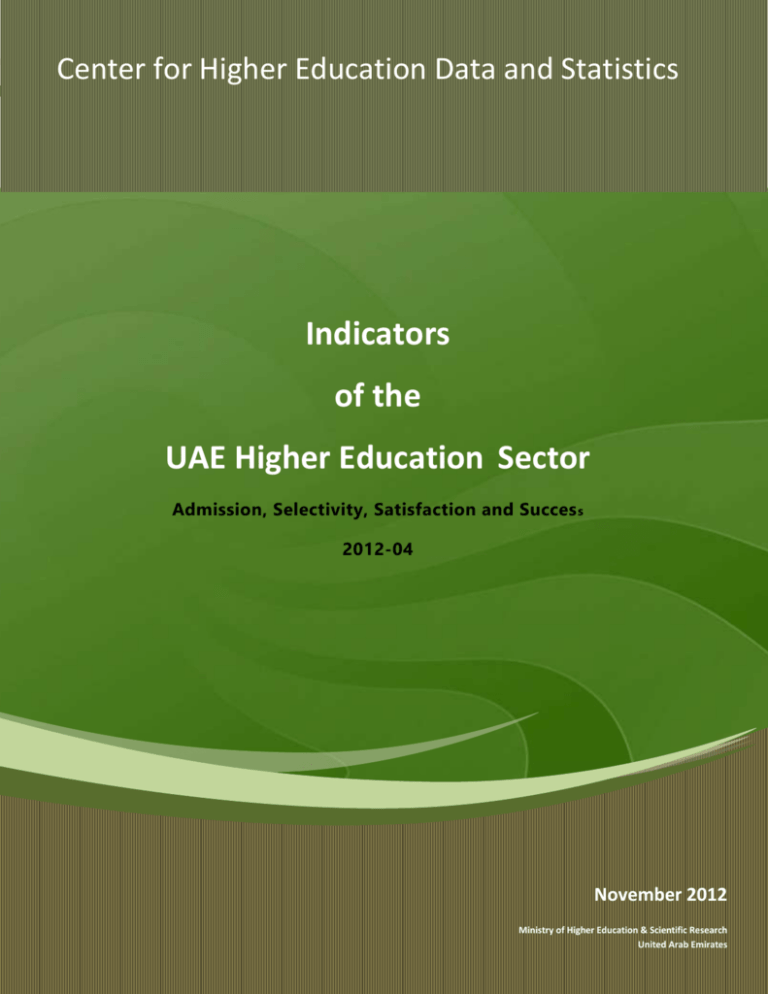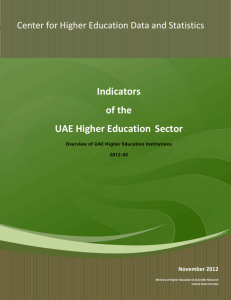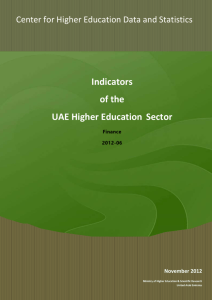Indicators of the UAE Higher Education Sector
advertisement

Indicators of the UAE HE Sector Center for Higher Education Data and Statistics Indicators of the UAE Higher Education Sector Admission, Selectivity, Satisfaction and Succes s 2012-04 November 2012 © Center for Higher Education Data and Statistics 1 Ministry of Higher Education & Scientific Research United Arab Emirates Indicators of the UAE HE Sector © Center for Higher Education Data and Statistics 2 Indicators of the UAE HE Sector CENTER FOR HIGHER EDUCATION DATA AND STATISTICS (CHEDS) INDICATORS OF THE UAE HIGHER EDUCATION SECTOR 2012 © Center for Higher Education Data and Statistics 3 Indicators of the UAE HE Sector CHEDS Publication 2012: 04 What is CHEDS? The Center for Higher Education Data and Statistics (CHEDS), located within the Commission for Academic Accreditation in the Ministry of Higher Education and Scientific Research, is the national body for the collection, analysis and reporting of data on higher education in the UAE. © 2012 Center for Higher Education Data and Statistics Ministry of Higher Education and Scientific Research PO Box 45133 Abu Dhabi United Arab Emirates www.cheds.ae © Center for Higher Education Data and Statistics 4 Indicators of the UAE HE Sector Academic Indicators: Admission, Selectivity, Satisfaction and Success (CHEDS Indicators 22-42) Indicators of academic activity and performance are obviously the heart of a higher education data collection. This report provides a sample of these indicators. 1. Access rate of new students Data reported from institutions show that the total number of new applicants is 69,870 (from UAE and abroad) and places were offered to 42,079 (60%), resulting in 30,263 new students at all level of studies. However, CHEDS traced 28,873 new students from the reported raw student data. The discrepancy between the two numbers is only 5% and may be due to new students at the institution but transferring from another institution being reported as transferred students rather than new; or because this first pilot collection took place in spring and retrospectively requested fall data (or, of course, because of errors in the data). The 28,873 new students are composed of 25,044 undergraduate students and 3,829 new graduate students. The new students were admitted to the various areas of specialization as shown in Figs 1 & 2, which indicate that Foreign languages, Arts, Science, and Education programs have the smallest intakes, whereas Business Administration, and Engineering programs have the highest intakes. CHEDS received the high school scores of 22,321 new students from the 25,044 students who appeared in the student records. The analysis of their high school scores indicates that the average score is 81%, the median is 81.5%, 25% of them had a score greater than 89%, and 25% had a score less than 74%. The minimum admission score is 60%. © Center for Higher Education Data and Statistics 5 Indicators of the UAE HE Sector 2. Transfer of students The number of students that had transferred from another institution is 6006, representing 5.5% of the total enrolments. There were 5,042 transfers within the UAE, 171 from GCC, 224 from other Arab countries, and 569 from other countries. This implies a high level of stability in educational attendance. 3. Clusters CHEDS computed indicators for 12 clusters of institutions which were identified using the following clustering criteria across four dimensions: Level of programs offered: p to Diploma, Bachelor degree, Master Degree, and Doctoral programs) (clusters 1-4) Size of institution: Small (<1,000 students), Medium (1,000 to 3,999 students), and Large (>3,999 students) (clusters 5-7) the federal institutions and the CAA-licensed institutions (clusters 8-9) Location of main campus: Abu Dhabi, Dubai, and Northern Emirates (Clusters 10-12) 4. Selectivity CHEDS computed three indicators normally associated with ‘selectivity ’, namely the number of offered places in relation to the number of applicants, the number of enrolled students in relation to the number of offered places, and the average High School score. The first of these indicators is shown in Fig. 3. This shows that Diploma, Medium, Large, and Federal Institutions have on average comparable selectivity rates (about 75-80%). © Center for Higher Education Data and Statistics 6 Indicators of the UAE HE Sector The result for the small institutions warrants more investigation. The group seems to be highly selective, making offers to only 20% of applicants. The explanation is clear from Fig. 4 (from which institution names have been omitted): it is due to the extreme selectivity of three institutions. The second selectivity indicator mentioned above (the rate of enrolments to offers) is 0.83 , 0.62 and 0.60 for the three institutions, indicating that a significant proportion of accepted applicants did not join the institution. 5. Satisfaction Student satisfaction and graduate satisfaction are represented in Fig. 5. ‘Rate’ denotes a normalised average of responses to a set of questions specified by CHEDS. The data suggests that students are more satisfied than graduates. Students and graduates of Abu Dhabi institutions seem more satisfied than the others. However, the lowest student satisfact ion (56%) is obtained for the cluster of small institutions, which is counter to the usual tendency. © Center for Higher Education Data and Statistics 7 Indicators of the UAE HE Sector The details of this cluster are depicted in Fig . 6, which shows that for most institutions the graduate satisfaction fluctuates around 60% except for two institutions which are about 30% and 40% respectively. © Center for Higher Education Data and Statistics 8 Indicators of the UAE HE Sector 6. Progress and Success Progress rate is the percentage of continuing students which are in good academic standing (CGPA >=2) and the success rate is defined as the percentage of credit p assed (including D grade) during the previous semester. Fig. 7 indicates that both progress and success indicators are similar for all clusters. Their values (around 80% & 90% respectively) are to be expected in institutions that follow the US assessment system. The fact that the progression rate is smaller than the success rate may be due to the implementation of academic warning policies in the HE institutions in the UAE which avoids accumulation of number of students who are not in good academic s tanding. These two indicators were also computed per area of specialization and the results showed a normal trend for all of them taking into account the specificity of the specialization. © Center for Higher Education Data and Statistics 9









